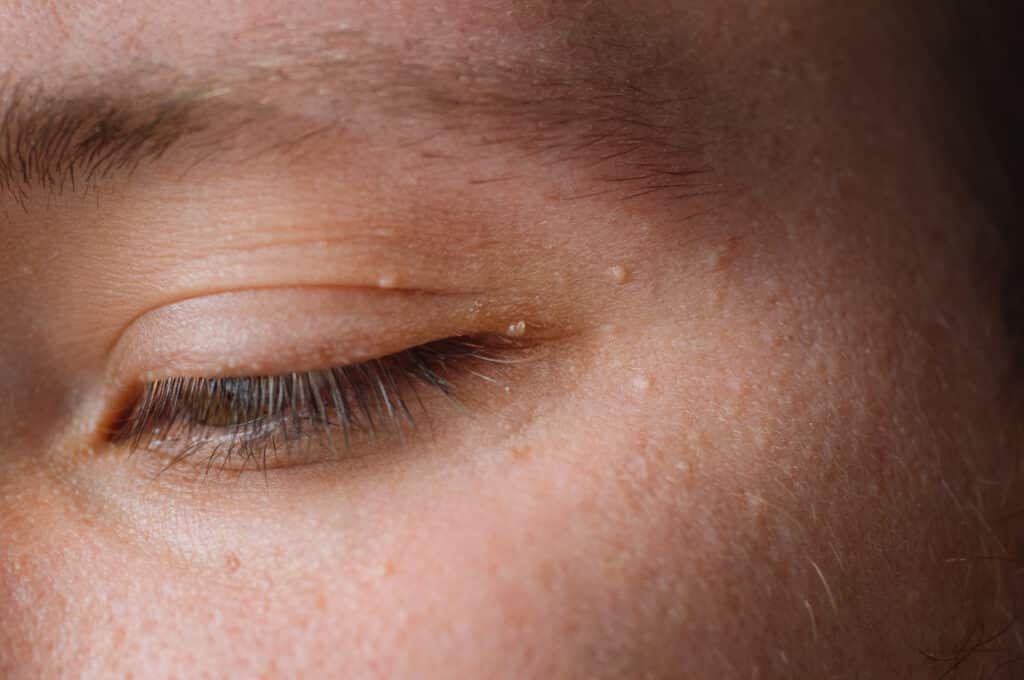Skin tags, also known as acrochordon, are common skin growths. They’re generally harmless and painless, but some people grow concerned by the appearance of a skin tag on their bodies. Are they a warning sign for something more sinister? Can they be removed? Read on to find out.
What are skin tags?
In simple terms, skin tags are benign tumours on the skin. They consist of a core of loosely arranged fibres, ducts, fat cells, and nerve cells. They are covered by skin or epidermis, which often makes them blend in with the rest of your skin, leading to them often going unnoticed.
Somewhat similar to warts, skin tags are skin growths characterised by a short, narrow stalk sticking out of your skin, often found on the neck, chest, eyelid, groin, or underarm. They can range in colour, size and texture. Some blend in with your own skin tone, while others are much darker or lighter. Some are no larger than 2mm, while others grow much larger. Some are smooth, rounded and even, while others are wrinkled and irregular.
No matter the appearance of your skin tag, it is almost always nothing serious. You can distinguish skin tags from warts because they tend to hang off the skin as opposed to laying flat on the surface of the skin. Unlike moles, they are not attached to a root.
When self-diagnosing a skin tag, it is possible to mistake them for something else. Skin tags share a similar appearance to a number of non-benign skin growths, so it is recommended to seek a professional opinion whenever you find a growth on your skin.
What causes skin tags?

Generally, skin tags are made of collagen (a type of protein) and blood vessels surrounded by skin. Skin tags occur when extra cells grow on the top layers of the skin. They often grow in areas where skin rubs against itself, like the folds of skin found in your armpit, groin and stomach. They can also grow in places where the skin has rubbed against clothing or jewellery for some time.
They are most common in older people, pregnant people, and those with Type 2 Diabetes, but skin tags can appear on anyone.
Should I be worried about my skin tags?
Skin tags rarely pose a health concern, but they can cause discomfort and irritation if they frequently rub against clothing or other folds of skin, and may even bleed.
One concern about skin tags is that other, more harmful skin growths can be mistaken for skin tags. If a new growth or spot appears on your body, it is best to have it looked at by a medical professional, especially if it bleeds or is a different colour to the rest of your skin. Skin tags stay the same size while cancerous growths continue to grow, so if your skin lesion changes in size or shape, it may not be a skin tag.
Multiple skin tags can be a symptom of Type 2 Diabetes or having too much insulin, but correlation does not always equal causation. Skin tags can be random and completely unrelated to insulin levels.
How should I remove skin tags?

While skin tags themselves are not dangerous, some choose to remove them for cosmetic purposes or if the skin tag causes pain, irritation or inconvenience.
Skin tags often drop off by themselves over time. Sometimes they come and go without even being noticed. But if you have a skin tag that is bothering you, talk to your doctor. Options for skin tag removal include freezing them with liquid nitrogen, cutting with a scalpel or surgical scissors, interrupting the blood supply to the skin tag with ligation, or cauterising them. These methods are generally done by a dermatologist or similarly trained doctor, but skin tags on the eyelids may need to be treated by an ophthalmologist or other eye specialist.
Keep in mind that home removal with scissors or nail clippers is not recommended, and can cause heavy bleeding and infection. Over-the-counter solutions or natural remedies may help to remove a skin tag at home, but it is best to confer with a doctor before trying these methods and to ensure that your skin tag is in fact a skin tag rather than a cancerous growth.




